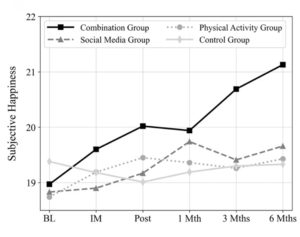
Source: Experimental longitudinal evidence for causal role of social media use and physical activity in COVID-19 burden and mental health
Making the effort to move more and scroll less is especially good advice for active couch potatoes, the scientific term for those of us who manage to squeeze in some exercise each day but spend the rest of the day sitting down. Despite the commitment to physical activity, active couch potatoes are at risk for a variety of health problems including high blood sugar, cholesterol, and body fat.
There is no doubt that taking time to workout is commendable and has well-established health benefits — the issue is what we do the rest of the day.
In 2012 I-Min Lee, an epidemiologist at Harvard University, published a landmark paper in The Lancet showing that prolonged periods of inactivity kills more than 5 million people every year, making the health risks similar to smoking and obesity. Spending the majority of our time immersed in low-energy activities like watching TV, working at a computer, and scrolling through social media has adverse psychological effects too.
The good news is that just a little more movement in our daily lives can make a big difference.
There is a clear link between moving more and feeling good. Individuals who are more physically active are happier. Moreover, individuals are happier in the moments when they are physically active. A study entitled Happy People Live More Active Lives published in PLOS ONE discovered that individuals who had been moving in the past fifteen minutes were in a better mood than when they had been reclining or sitting down. Of note, “non-exercise” physical activity i.e. non-rigorous exercise such as standing and walking contribute to both physical health and happiness. Putting one foot in front of the other can be enough to brighten your mood and even turn a bad day around.
There is no need to spend extra time at the gym or wake up earlier to jog that extra mile. The key is to try and move just a little more.
- Add more non-exercise movement to each day
Schedule a casual stroll around the block at lunchtime. Meander down the hall at the end of each hour. Turn phone calls into walking opportunities. Getting off the bus a stop before your regular stop, using the stairs instead of the elevator, taking the dog for an extra loop around the block, parking a little further away from your destination, and going for a walk after dinner instead of collapsing on the couch are all small but effective ways to increase the amount of physical activity in your day. No need to break a sweat or put on sneakers.
- If you sit a lot, try to sit in “active resting” positions
Consider getting an inflatable ball for sitting at your desk. During leisure time, sit on the floor sometimes. If you cannot resist reclining, be sure to stand up regularly and stretch your legs.
- If you’re reading this sitting down, stand up, and take a walk
Bottom Line: Take advantage of every opportunity to move, even when you’re not in the mood. While you’re at it, put your phone away.
I wish you all the best,
Dr. Samantha Boardman






